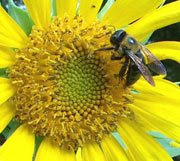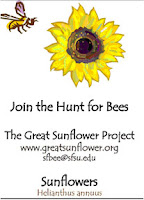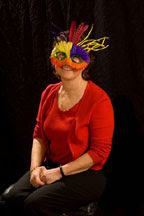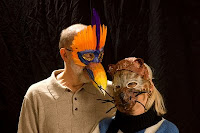
Over the last week or so, I've been working to source good quality seeds and create sunflower growing instructions and graphics for The Great Sunflower Project. This fascinating and ambitious "citizen science" project was founded and is directed by Dr. Gretchen LeBuhn, a conservation biologist and associate professor at San Francisco State University. She is particularly interested in the effects of climate change on bee communities and this project is creating data to help understand what is happening to the bee pollinators in all the different bee species, focusing on urban and semi-urban areas.
Here's how Dr. LeBuhn describes the background of the project for participants:
 "We know that pollinators are declining in certain wild and many agricultural landscapes. However, little is known about urban pollinators. Because natural habitats are uncommon in urban landscapes, they may not provide enough resources to support viable pollinator communities. However, if other habitats, such as urban gardens and restored areas, are sufficiently connected to natural habitat, then native populations may thrive.
"We know that pollinators are declining in certain wild and many agricultural landscapes. However, little is known about urban pollinators. Because natural habitats are uncommon in urban landscapes, they may not provide enough resources to support viable pollinator communities. However, if other habitats, such as urban gardens and restored areas, are sufficiently connected to natural habitat, then native populations may thrive.
By finding a way to track and value the goods and services provided by natural ecosystems, we will find a future in which conservation is not a luxury but a guiding principle of daily decision-making throughout the world. The data you collect from your sunflower will be a start. It will provide an insight into how our green spaces in the urban, suburban and rural landscapes are connected as well as shedding light on how to help pollinators. The Great Sunflower Project is the first step."
 The Project works by sending a sunflower seed packet to all the individual volunteers who sign up on The Great Sunflower Website to get one and agree to collect data on the bees attracted by the flowers. I'm pleased and proud to have been selected to write the packet to ensure growing success and provide the sunflower seeds for The Sunflower Project' s 2009 seed packet. When the these seeds are sown, grow and flower, the volunteers will be observing and reporting on the bees that visit them, using standardized data sheets that are then sent back to the Project for analysis.
The Project works by sending a sunflower seed packet to all the individual volunteers who sign up on The Great Sunflower Website to get one and agree to collect data on the bees attracted by the flowers. I'm pleased and proud to have been selected to write the packet to ensure growing success and provide the sunflower seeds for The Sunflower Project' s 2009 seed packet. When the these seeds are sown, grow and flower, the volunteers will be observing and reporting on the bees that visit them, using standardized data sheets that are then sent back to the Project for analysis.
Currently, 40,000 American and Canadian volunteers ranging from preschoolers to master gardeners and from rural, suburban and metropolitan locations are participating.
 With the help of her students Fern Canton and Shannon Messerly, Dr. LeBuhn is looking forward to getting a wide range of data about urban bee populations that would not otherwise be available: "We have grown a ‘virtual’ community of teachers, community gardeners, nature center staff, beekeepers, pollinator enthusiasts, retirees, home schooling groups and parents interested in participating in a project with their children. If everyone plants seeds this year, we will have sunflower samples from the Arctic Circle to the tip of Florida and west to Hawaii and east to Puerto Rico!"
With the help of her students Fern Canton and Shannon Messerly, Dr. LeBuhn is looking forward to getting a wide range of data about urban bee populations that would not otherwise be available: "We have grown a ‘virtual’ community of teachers, community gardeners, nature center staff, beekeepers, pollinator enthusiasts, retirees, home schooling groups and parents interested in participating in a project with their children. If everyone plants seeds this year, we will have sunflower samples from the Arctic Circle to the tip of Florida and west to Hawaii and east to Puerto Rico!"
You can see a map with about 25,000 of the locations on the Great Sunflower Project Website http://www.greatsunflower.org/
 Last year, the project had the misfortune to use a sunflower species from another seed company that didn't germinate at all well and was very disappointing. This season, Dr. LeBuhn came to me looking for a sunflower that was produces pollen, has multiple flower heads and was easy to grow and attractive. I settled on a wonderful old-fashioned variety called "Lemon Queen" and have written the packet back expressly for beginning gardeners since many of the folks who are participating in the project haven't had much garden experience. Today I finally sent the packets off to the printer to start things rolling and ordered the seeds to be shipped for filling the packets once they are produced.
Last year, the project had the misfortune to use a sunflower species from another seed company that didn't germinate at all well and was very disappointing. This season, Dr. LeBuhn came to me looking for a sunflower that was produces pollen, has multiple flower heads and was easy to grow and attractive. I settled on a wonderful old-fashioned variety called "Lemon Queen" and have written the packet back expressly for beginning gardeners since many of the folks who are participating in the project haven't had much garden experience. Today I finally sent the packets off to the printer to start things rolling and ordered the seeds to be shipped for filling the packets once they are produced.
 In addition to personally contributing in building an important database about bees, participants can really learn about both honey bees and lesser-known native species. Besides, it's really fun to be part of a big effort like this! I'd like to encourage everybody to go to their website and sign up to do this project! We will plan to have a great big row of Lemon Queen in our trial gardens this year. This is an interesting and serendipitous way to find a new variety, but if all goes well, we'll probably also add Lemon Queen to Renee's Garden in 2010.
In addition to personally contributing in building an important database about bees, participants can really learn about both honey bees and lesser-known native species. Besides, it's really fun to be part of a big effort like this! I'd like to encourage everybody to go to their website and sign up to do this project! We will plan to have a great big row of Lemon Queen in our trial gardens this year. This is an interesting and serendipitous way to find a new variety, but if all goes well, we'll probably also add Lemon Queen to Renee's Garden in 2010.
 "We know that pollinators are declining in certain wild and many agricultural landscapes. However, little is known about urban pollinators. Because natural habitats are uncommon in urban landscapes, they may not provide enough resources to support viable pollinator communities. However, if other habitats, such as urban gardens and restored areas, are sufficiently connected to natural habitat, then native populations may thrive.
"We know that pollinators are declining in certain wild and many agricultural landscapes. However, little is known about urban pollinators. Because natural habitats are uncommon in urban landscapes, they may not provide enough resources to support viable pollinator communities. However, if other habitats, such as urban gardens and restored areas, are sufficiently connected to natural habitat, then native populations may thrive.By finding a way to track and value the goods and services provided by natural ecosystems, we will find a future in which conservation is not a luxury but a guiding principle of daily decision-making throughout the world. The data you collect from your sunflower will be a start. It will provide an insight into how our green spaces in the urban, suburban and rural landscapes are connected as well as shedding light on how to help pollinators. The Great Sunflower Project is the first step."
 The Project works by sending a sunflower seed packet to all the individual volunteers who sign up on The Great Sunflower Website to get one and agree to collect data on the bees attracted by the flowers. I'm pleased and proud to have been selected to write the packet to ensure growing success and provide the sunflower seeds for The Sunflower Project' s 2009 seed packet. When the these seeds are sown, grow and flower, the volunteers will be observing and reporting on the bees that visit them, using standardized data sheets that are then sent back to the Project for analysis.
The Project works by sending a sunflower seed packet to all the individual volunteers who sign up on The Great Sunflower Website to get one and agree to collect data on the bees attracted by the flowers. I'm pleased and proud to have been selected to write the packet to ensure growing success and provide the sunflower seeds for The Sunflower Project' s 2009 seed packet. When the these seeds are sown, grow and flower, the volunteers will be observing and reporting on the bees that visit them, using standardized data sheets that are then sent back to the Project for analysis.Currently, 40,000 American and Canadian volunteers ranging from preschoolers to master gardeners and from rural, suburban and metropolitan locations are participating.
 With the help of her students Fern Canton and Shannon Messerly, Dr. LeBuhn is looking forward to getting a wide range of data about urban bee populations that would not otherwise be available: "We have grown a ‘virtual’ community of teachers, community gardeners, nature center staff, beekeepers, pollinator enthusiasts, retirees, home schooling groups and parents interested in participating in a project with their children. If everyone plants seeds this year, we will have sunflower samples from the Arctic Circle to the tip of Florida and west to Hawaii and east to Puerto Rico!"
With the help of her students Fern Canton and Shannon Messerly, Dr. LeBuhn is looking forward to getting a wide range of data about urban bee populations that would not otherwise be available: "We have grown a ‘virtual’ community of teachers, community gardeners, nature center staff, beekeepers, pollinator enthusiasts, retirees, home schooling groups and parents interested in participating in a project with their children. If everyone plants seeds this year, we will have sunflower samples from the Arctic Circle to the tip of Florida and west to Hawaii and east to Puerto Rico!"You can see a map with about 25,000 of the locations on the Great Sunflower Project Website http://www.greatsunflower.org/
 Last year, the project had the misfortune to use a sunflower species from another seed company that didn't germinate at all well and was very disappointing. This season, Dr. LeBuhn came to me looking for a sunflower that was produces pollen, has multiple flower heads and was easy to grow and attractive. I settled on a wonderful old-fashioned variety called "Lemon Queen" and have written the packet back expressly for beginning gardeners since many of the folks who are participating in the project haven't had much garden experience. Today I finally sent the packets off to the printer to start things rolling and ordered the seeds to be shipped for filling the packets once they are produced.
Last year, the project had the misfortune to use a sunflower species from another seed company that didn't germinate at all well and was very disappointing. This season, Dr. LeBuhn came to me looking for a sunflower that was produces pollen, has multiple flower heads and was easy to grow and attractive. I settled on a wonderful old-fashioned variety called "Lemon Queen" and have written the packet back expressly for beginning gardeners since many of the folks who are participating in the project haven't had much garden experience. Today I finally sent the packets off to the printer to start things rolling and ordered the seeds to be shipped for filling the packets once they are produced. In addition to personally contributing in building an important database about bees, participants can really learn about both honey bees and lesser-known native species. Besides, it's really fun to be part of a big effort like this! I'd like to encourage everybody to go to their website and sign up to do this project! We will plan to have a great big row of Lemon Queen in our trial gardens this year. This is an interesting and serendipitous way to find a new variety, but if all goes well, we'll probably also add Lemon Queen to Renee's Garden in 2010.
In addition to personally contributing in building an important database about bees, participants can really learn about both honey bees and lesser-known native species. Besides, it's really fun to be part of a big effort like this! I'd like to encourage everybody to go to their website and sign up to do this project! We will plan to have a great big row of Lemon Queen in our trial gardens this year. This is an interesting and serendipitous way to find a new variety, but if all goes well, we'll probably also add Lemon Queen to Renee's Garden in 2010. 




